wheel size SKODA SUPERB 2009 2.G / (B6/3T) Owner's Manual
[x] Cancel search | Manufacturer: SKODA, Model Year: 2009, Model line: SUPERB, Model: SKODA SUPERB 2009 2.G / (B6/3T)Pages: 294, PDF Size: 21.33 MB
Page 79 of 294
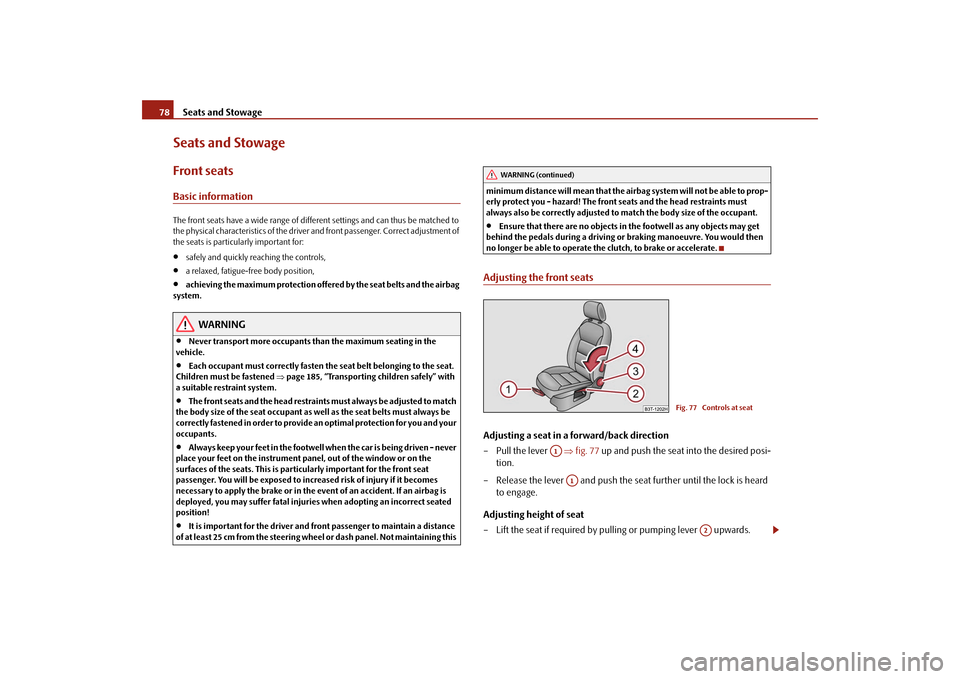
Seats and Stowage
78
Seats and StowageFront seatsBasic informationThe front seats have a wide range of different settings and can thus be matched to the physical characteristics of the driver and front passenger. Correct adjustment of the seats is particularly important for:•
safely and quickly reaching the controls,
•
a relaxed, fatigue-free body position,
•
achieving the maximum protection offere
d by the seat belts and the airbag
system.
WARNING
•
Never transport more occupants than the maximum seating in the
vehicle.•
Each occupant must correctly fasten
the seat belt belonging to the seat.
Children must be fastened
⇒page 185, “Transporting children safely” with
a suitable restraint system.•
The front seats and the head restraints must always be adjusted to match
the body size of the seat occupant as well as the seat belts must always be correctly fastened in order to provide an optimal protection for you and your occupants.•
Always keep your feet in the footwell
when the car is being driven - never
place your feet on the instrument panel, out of the window or on the surfaces of the seats. This is particularly important for the front seat passenger. You will be exposed to increased risk of injury if it becomes necessary to apply the brake or in the event of an accident. If an airbag is deployed, you may suffer fatal injuries
when adopting an incorrect seated
position!•
It is important for the driver and front passenger to maintain a distance
of at least 25 cm from the steering wheel
or dash panel. Not maintaining this
minimum distance will mean that the airbag system will not be able to prop- erly protect you - hazard! The front
seats and the head restraints must
always also be correctly adjusted to match the body size of the occupant.•
Ensure that there are no objects in
the footwell as any objects may get
behind the pedals during a driving or
braking manoeuvre. You would then
no longer be able to operate the clutch, to brake or accelerate.Adjusting the front seatsAdjusting a seat in a forward/back direction – Pull the lever
⇒
fig. 77
up and push the seat into the desired posi-
tion.
– Release the lever and push the seat further until the lock is heard
to engage.
Adjusting height of seat – Lift the seat if required by pulling or pumping lever upwards.
WARNING (continued)
Fig. 77 Controls at seat
A1
A1
A2
s2dk.1.book Page 78 Wednesday, April 8, 2009 12:23 PM
Page 125 of 294

Starting-off and Driving
124
Activating The parking aid is activated when the
reverse gear
is engaged and the ignition is
turned on or by pressing the button
⇒page 123, fig. 139
- the symbol
lights up
in the button. The activation is confir
med by a brief acknowledgement signal.
Deactivating The parking aid is deactivated after pressing the button°
⇒page 123, fig. 139
or
at a speed of more than 10 km/h - the symbol
in the button is no longer illumi-
nated.
WARNING
•
The parking aid is not a substitute fo
r the driver paying proper attention
and it is always the driver's responsibility to take care when reversing the vehicle or carrying ou
t similar manoeuvres.
•
You should therefore satisfy yourself, before reversing, that there is no
small obstacle, such as a rock, thin post, trailer drawbar etc., in front or behind your vehicle. Such an obstacle might not be within the range detected by the sensors.•
Under certain circumstances, surfaces
of certain objects and types of
clothing cannot reflect the signal of the parking aid. Thus, these objects or people who wear such clothing are not recognised by the sensors of the parking aid.
Note
•
Only the front parking aid operates if yo
u are towing a trailer (applies only to
models which feature a factor
y-fitted towing device*).
•
If a warning signal sounds for about 3 seconds after activating the system and
there is no obstacle close to your car, th
is indicates a system fault. The fault is
confirmed additionally when the symbol
flashes in the button
⇒page 123,
fig. 139
. Have the fault rectified by a specialist workshop.
•
The sensors must be kept clean and free
of ice to enable the parking aid to
operate properly.
•
If the parking aid is activated and the se
lector lever of the automatic gearbox is
in the position , warning signal indicates interruption (vehicle can no longer move).Park Assist*Description and important informationThe park assist assists you when parkin
g in a suitable parallel parking place
between two vehicles or behind a vehicle. The park assist automatically searches fo
r suitable parking spaces after switching
on the ignition and when driving up to 30 km/h. During the parking procedure the park as
sist only takes over the steering move-
ments, the pedals continue to
be operated by the driver.
Function of the system is based on:•
Length and depth measurement of
the parking spaces when driving
•
Evaluation of the size
of the parking space
•
Definition of the correct position of the vehicle for parking
•
Calculating the line on which the vehi
cle drives backwards into the parking
place•
Actuation of the steering force assistan
ce, automatic spinning of the wheels of
the front axle when parking.
WARNING
The park assist does not take away the responsability from the driver when parking.•
Pay particular attention to small chil
dren and animals as they would not
be recognised by the se
nsors of the parking aid.
•
Under certain circumstances, surfaces of certain objects and types of
clothing cannot reflect the signal of th
e park assist or th
e parking aid. Thus,
AP
s2dk.1.book Page 124 Wednesday, April 8, 2009 12:23 PM
Page 126 of 294
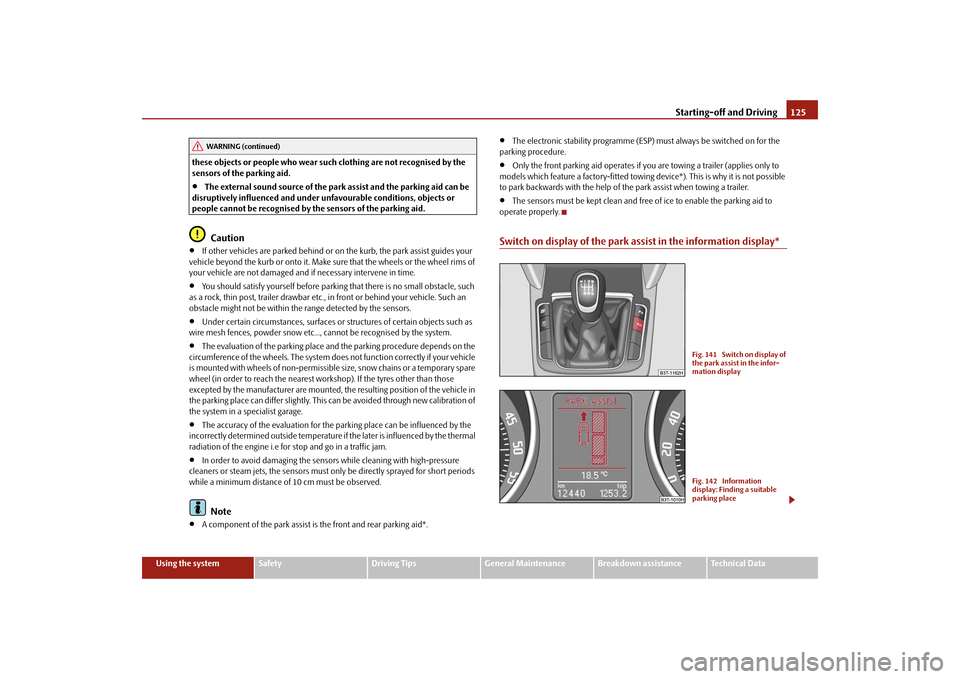
Starting-off and Driving
125
Using the system
Safety
Driving Tips
General Maintenance
Breakdown assistance
Technical Data
these objects or people who wear such clothing are not recognised by the sensors of the parking aid.•
The external sound source of the park assist and the parking aid can be
disruptively influenced and under unfavourable conditions, objects or people cannot be recognised by the sensors of the parking aid.
Caution
•
If other vehicles are parked
behind or on the kurb, the park assist guides your
vehicle beyond the kurb or onto it. Make sure that the wheels or the wheel rims of your vehicle are not damaged and
if necessary intervene in time.
•
You should satisfy yourself before parkin
g that there is no small obstacle, such
as a rock, thin post, trailer drawbar etc., in
front or behind your vehicle. Such an
obstacle might not be within the range detected by the sensors.•
Under certain circumstances, surfaces or structures of certain objects such as
wire mesh fences, powder snow etc...,
cannot be recognised by the system.
•
The evaluation of the parking place and the parking procedure depends on the
circumference of the wheels. The system does
not function correctly if your vehicle
is mounted with wheels of non-permissible size, snow chains or a temporary spare wheel (in order to reach the nearest workshop). If the tyres other than those excepted by the manufacturer are mounted,
the resulting position of the vehicle in
the parking place can differ slightly. This
can be avoided throug
h new calibration of
the system in a specialist garage.•
The accuracy of the evaluation for the
parking place can be influenced by the
incorrectly determined outside temperature if
the later is influenced by the thermal
radiation of the engine i.e for stop and go in a traffic jam.•
In order to avoid damaging the sensor
s while cleaning with high-pressure
cleaners or steam jets, the sensors must on
ly be directly sprayed for short periods
while a minimum distance of 10 cm must be observed.
Note
•
A component of the park assist is
the front and rear parking aid*.
•
The electronic stability programme (ESP)
must always be switched on for the
parking procedure.•
Only the front parking aid operates if you are towing a trailer (applies only to
models which feature a factory-fitted towing device*). This is why it is not possible to park backwards with the help of th
e park assist when
towing a trailer.
•
The sensors must be kept clean and free of ice to enable the parking aid to
operate properly.Switch on display of the park assist in the information display*
WARNING (continued)
Fig. 141 Switch on display of the park assist in the infor-mation displayFig. 142 Information display: Finding a suitable parking place
s2dk.1.book Page 125 Wednesday, April 8, 2009 12:23 PM
Page 165 of 294
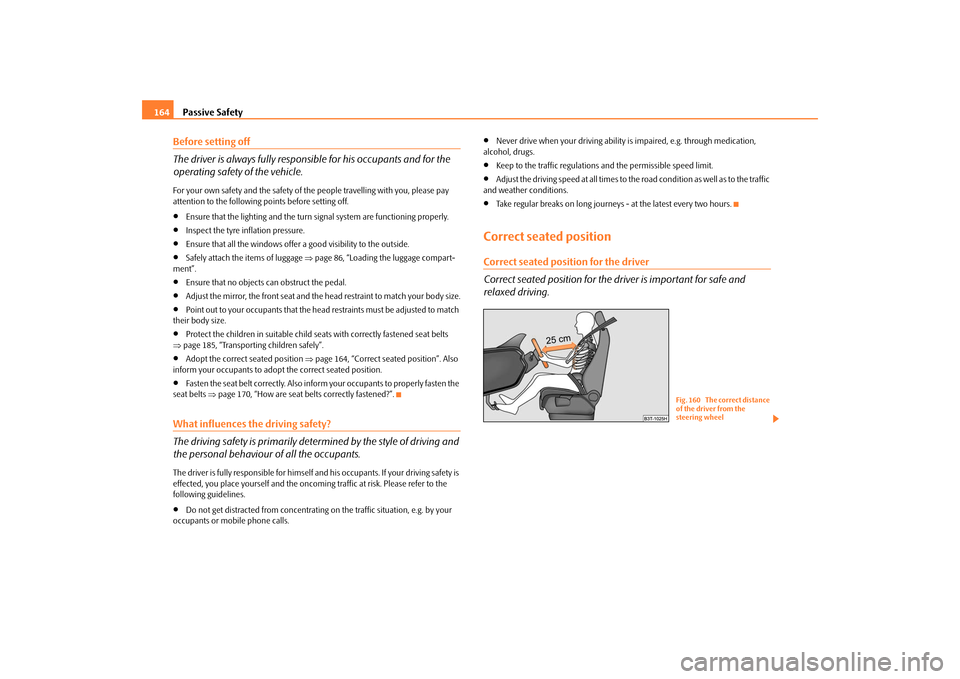
Passive Safety
164
Before setting off The driver is always fully respon
sible for his occupants and for the
operating safety of the vehicle.For your own safety and the safety of the
people travelling with you, please pay
attention to the following points before setting off.•
Ensure that the lighting and the turn signal system are functioning properly.
•
Inspect the tyre inflation pressure.
•
Ensure that all the windows offer a good visibility to the outside.
•
Safely attach the items of luggage
⇒page 86, “Loading the luggage compart-
ment”.•
Ensure that no objects can obstruct the pedal.
•
Adjust the mirror, the front seat and the head restraint to match your body size.
•
Point out to your occupants that the head restraints must be adjusted to match
their body size.•
Protect the children in suitable child se
ats with correctly fastened seat belts
⇒ page 185, “Transporting children safely”.•
Adopt the correct seated position
⇒page 164, “Correct seated position”. Also
inform your occupants to adop
t the correct seated position.
•
Fasten the seat belt correctly. Also inform your occupants to properly fasten the
seat belts
⇒page 170, “How are seat belts correctly fastened?”.
What influences the driving safety? The driving safety is primarily dete
rmined by the style of driving and
the personal behaviour of all the occupants.The driver is fully responsible for himself and his occupants. If your driving safety is effected, you place yourself and the oncomi
ng traffic at risk. Please refer to the
following guidelines.•
Do not get distracted from concentrating on the traffic situation, e.g. by your
occupants or mobile phone calls.
•
Never drive when your driving ability is impaired, e.g. through medication,
alcohol, drugs.•
Keep to the traffic regulations and the permissible speed limit.
•
Adjust the driving speed at all times to the road condition as well as to the traffic
and weather conditions.•
Take regular breaks on long journeys - at the latest every two hours.
Correct seated positionCorrect seated position for the driver Correct seated position for the dr
iver is important for safe and
relaxed driving.
Fig. 160 The correct distance of the driver from the steering wheel
s2dk.1.book Page 164 Wednesday, April 8, 2009 12:23 PM
Page 166 of 294
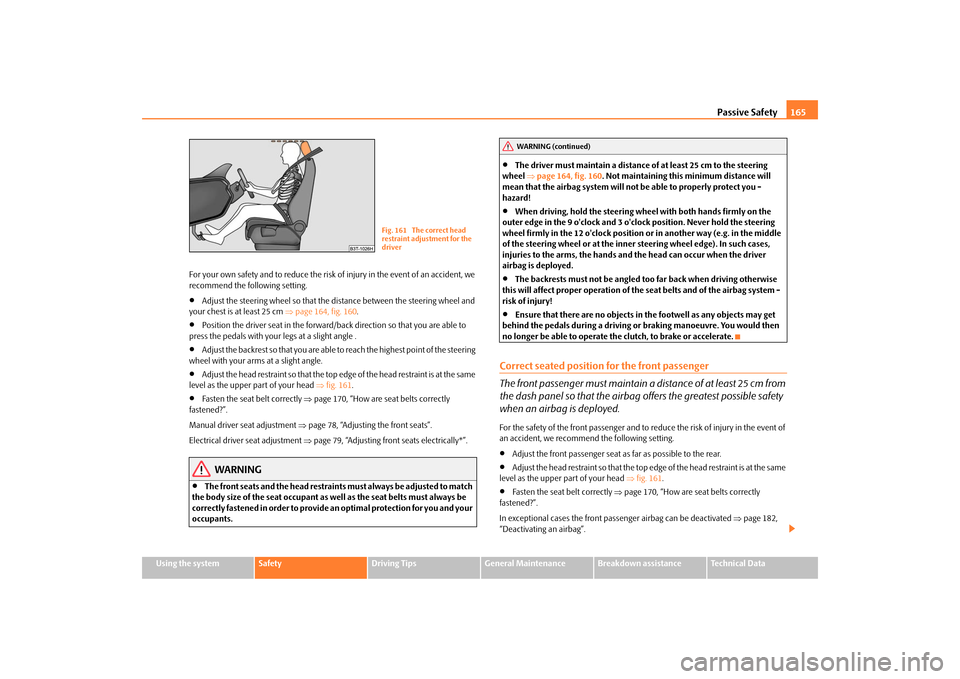
Passive Safety
165
Using the system
Safety
Driving Tips
General Maintenance
Breakdown assistance
Technical Data
For your own safety and to reduce the risk of injury in the event of an accident, we recommend the following setting.•
Adjust the steering wheel so that the distance between the steering wheel and
your chest is at least 25 cm
⇒page 164, fig. 160
.
•
Position the driver seat in the forward/back direction so that you are able to
press the pedals with your
legs at a slight angle .
•
Adjust the backrest so that you are able
to reach the highest point of the steering
wheel with your arms at a slight angle.•
Adjust the head restraint so that the top edge of the head restraint is at the same
level as the upper part of your head
⇒fig. 161
.
•
Fasten the seat belt correctly
⇒page 170, “How are seat belts correctly
fastened?”. Manual driver seat adjustment
⇒page 78, “Adjusting the front seats”.
Electrical driver seat adjustment
⇒page 79, “Adjusting front seats electrically*”.
WARNING
•
The front seats and the head restraints must always be adjusted to match
the body size of the seat occupant as well as the seat belts must always be correctly fastened in order to provide an optimal protection for you and your occupants.
•
The driver must maintain a distance of at least 25 cm to the steering
wheel
⇒page 164, fig. 160
. Not maintaining this minimum distance will
mean that the airbag system will not be able to properly protect you - hazard!•
When driving, hold the steering wheel
with both hands firmly on the
outer edge in the 9 o'clock and 3 o'clock position. Never hold the steering wheel firmly in the 12 o'clock position or in another way (e.g. in the middle of the steering wheel or
at the inner steering wheel edge). In such cases,
injuries to the arms, the hands and
the head can occur when the driver
airbag is deployed.•
The backrests must not be angled to
o far back when driving otherwise
this will affect proper operation of the seat belts and of the airbag system - risk of injury!•
Ensure that there are no objects in the footwell as any objects may get
behind the pedals during a driving or
braking manoeuvre. You would then
no longer be able to operate the clutch, to brake or accelerate.Correct seated position for the front passenger The front passenger must maintain a distance of at least 25 cm from the dash panel so that the airbag offers the greatest possible safety when an airbag is deployed.For the safety of the front passenger and to
reduce the risk of injury in the event of
an accident, we recommend the following setting.•
Adjust the front passenger seat as far as possible to the rear.
•
Adjust the head restraint so that the top edge of the head restraint is at the same
level as the upper part of your head
⇒fig. 161
.
•
Fasten the seat belt correctly
⇒page 170, “How are seat belts correctly
fastened?”. In exceptional cases the front pass
enger airbag can be deactivated
⇒page 182,
“Deactivating an airbag”.
Fig. 161 The correct head restraint adjustment for the driver
WARNING (continued)
s2dk.1.book Page 165 Wednesday, April 8, 2009 12:23 PM
Page 178 of 294
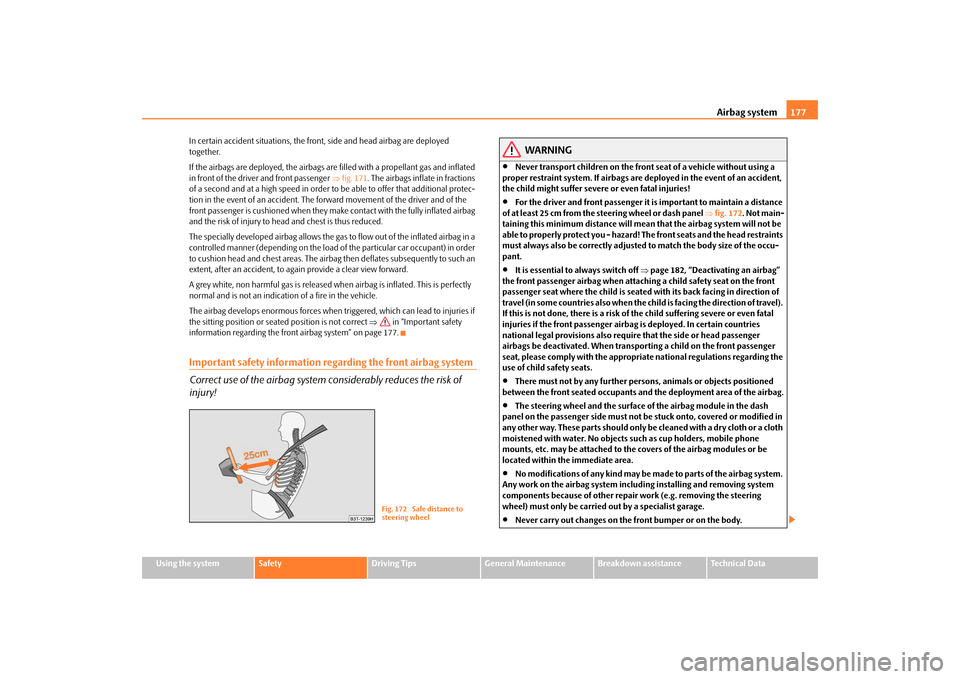
Airbag system
177
Using the system
Safety
Driving Tips
General Maintenance
Breakdown assistance
Technical Data
In certain accident situations, the front, side and head airbag are deployed together. If the airbags are deployed, the airbags are filled with a propellant gas and inflated in front of the driver and front passenger
⇒fig. 171
. The airbags inflate in fractions
of a second and at a high speed in order to
be able to offer that additional protec-
tion in the event of an accident. The forward movement of the driver and of the front passenger is cushioned when they make
contact with the fully inflated airbag
and the risk of injury to head and chest is thus reduced. The specially developed airbag allows the gas
to flow out of the inflated airbag in a
controlled manner (depending on the load
of the particular car occupant) in order
to cushion head and chest areas. The airbag
then deflates subsequently to such an
extent, after an accident, to again provide a clear view forward. A grey white, non harmful gas is released when airbag is inflated. This is perfectly normal and is not an indication of a fire in the vehicle. The airbag develops enormous forces when triggered, which can lead to injuries if the sitting position or seated position is not correct
⇒
in “Important safety
information regarding the front airbag system” on page 177.Important safety information regarding the front airbag system Correct use of the airbag system considerably reduces the risk of injury!
WARNING
•
Never transport children on the front seat of a vehicle without using a
proper restraint system. If airbags are
deployed in the event of an accident,
the child might suffer severe or even fatal injuries!•
For the driver and front passenger it is important to maintain a distance
of at least 25 cm from the steering wheel or dash panel
⇒fig. 172
. Not main-
taining this minimum distance will mean that the airbag system will not be able to properly protect you - hazard!
The front seats and the head restraints
must always also be correctly adjusted to match the body size of the occu- pant.•
It is essential to always switch off
⇒page 182, “Deactivating an airbag”
the front passenger airbag when attaching a child safety seat on the front passenger seat where the child is seated
with its back facing in direction of
travel (in some countries al
so when the child is facing the direction of travel).
If this is not done, there is a risk of
the child suffering severe or even fatal
injuries if the front passenger airbag
is deployed. In certain countries
national legal provisions also requir
e that the side or head passenger
airbags be deactivated. When transpor
ting a child on the front passenger
seat, please comply with the appropriate national regulations regarding the use of child safety seats.•
There must not by any further persons, animals or objects positioned
between the front seated occupants and the deployment area of the airbag.•
The steering wheel and the surface of
the airbag module in the dash
panel on the passenger side must not be stuck onto, covered or modified in any other way. These parts should only be cleaned with a dry cloth or a cloth moistened with water. No objects such as cup holders, mobile phone mounts, etc. may be attached to the covers of the airbag modules or be located within the immediate area.•
No modifications of any kind may be made to parts of the airbag system.
Any work on the airbag system includ
ing installing and removing system
components because of other repair
work (e.g. removing the steering
wheel) must only be carried
out by a specialist garage.
•
Never carry out changes on the front bumper or on the body.
Fig. 172 Safe distance to steering wheel
s2dk.1.book Page 177 Wednesday, April 8, 2009 12:23 PM
Page 236 of 294
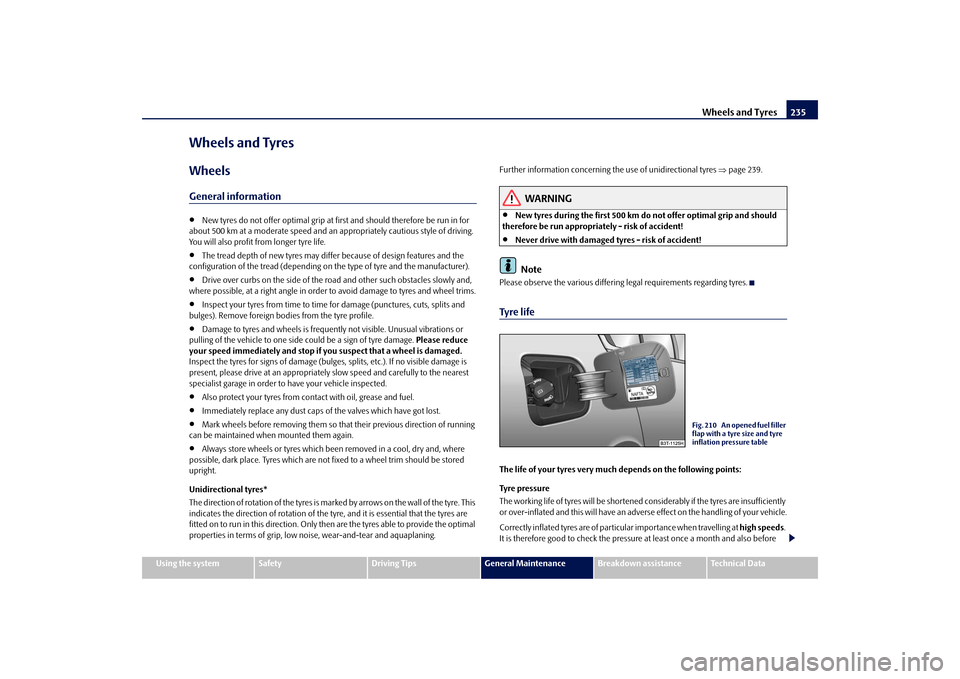
Wheels and Tyres
235
Using the system
Safety
Driving Tips
General Maintenance
Breakdown assistance
Technical Data
Wheels and TyresWheelsGeneral information•
New tyres do not offer optimal grip at first and should therefore be run in for
about 500 km at a moderate speed and an
appropriately cautious style of driving.
You will also profit from longer tyre life.•
The tread depth of new tyres may differ
because of design features and the
configuration of the tread (depending on
the type of tyre and the manufacturer).
•
Drive over curbs on the side of the road
and other such obstacles slowly and,
where possible, at a right angle in order to avoid damage to tyres and wheel trims.•
Inspect your tyres from time to time
for damage (punctures, cuts, splits and
bulges). Remove foreign bodies from the tyre profile.•
Damage to tyres and wheels is frequent
ly not visible. Unus
ual vibrations or
pulling of the vehicle to one side
could be a sign of tyre damage.
Please reduce
your speed immediately and stop if
you suspect that a wheel is damaged.
Inspect the tyres for signs of damage (bulges,
splits, etc.). If no
visible damage is
present, please drive at an appropriatel
y slow speed and carefully to the nearest
specialist garage in order to have your vehicle inspected.•
Also protect your tyres from contact with oil, grease and fuel.
•
Immediately replace any dust caps of the valves which have got lost.
•
Mark wheels before removing them so th
at their previous direction of running
can be maintained when mounted them again.•
Always store wheels or tyres which been removed in a cool, dry and, where
possible, dark place. Tyres which are not fixed to a wheel trim should be stored upright. Unidirectional tyres* The direction of rotation of the tyres is marked by arrows on the wall of the tyre. This indicates the direction of rotation of the tyre, and it is essential that the tyres are fitted on to run in this direction. Only then
are the tyres able to provide the optimal
properties in terms of grip, low noise, wear-and-tear and aquaplaning.
Further information concerning
the use of unidi
rectional tyres
⇒page 239.
WARNING
•
New tyres during the first 500 km do not offer optimal grip and should
therefore be run appropriately - risk of accident!•
Never drive with damaged tyres - risk of accident!Note
Please observe the various differing legal requirements regarding tyres.Tyre lifeThe life of your tyres very much depends on the following points: Tyre pressure The working life of tyres will be shortened considerably if the tyres are insufficiently or over-inflated and this will have an advers
e effect on the handli
ng of your vehicle.
Correctly inflated tyres are of partic
ular importance when travelling at
high speeds
.
It is therefore good to check the pressure at least once a month and also before
Fig. 210 An opened fuel filler flap with a tyre size and tyre inflation pressure table
s2dk.1.book Page 235 Wednesday, April 8, 2009 12:23 PM
Page 238 of 294

Wheels and Tyres
237
Using the system
Safety
Driving Tips
General Maintenance
Breakdown assistance
Technical Data
Changing wheels aroundIf significantly greater wear is present on the front tyres, we recommend changing the front wheels around with the rear wheels as shown in the diagram
⇒fig. 212
.
You will then obtain approximately the same life for all the tyres. It may be advantageous to swap the tyre
s over “crosswise” when certain types of
wear characteristic arise on
the running surface of the tyres (but not in the case of
unidirectional tyres). The co-workers of the authorised Škoda Service Partners are extensively familiar with the combination possibilites. We recommend that you change the wheels around every 10 000 km in order to achieve even wear on all wheels and to obtain optimal tyre life.New tyres and wheelsTyres and wheel rims are important design
elements. One should therefore use the
tyres and wheel rims which have been released for use by Škoda Auto. They are exactly matched to the vehicle type and th
erefore contribute significantly to good
road holding and safe driving characteristics
⇒
.
Only fit radial tyres of the same type on
all 4 wheels, size (rolling circumference)
and, if possible, the same tread pattern on one axle. The authorised Škoda Service Partners have access to the most current information about which tyres we have rele
ased for use on your vehicle.
We recommend that you have any work rela
ting to tyres or wheels carried out by
an authorised Škoda Service Partner
. The authorised Škoda Service Partners
have all of the necessary special tools
and replacement parts available plus the
required specialist knowledge and are also in a position to properly dispose of the old tyres. A large number of authorised Škod
a Service Partners also have an attrac-
tive range of tyres and wheels available. The tyre/wheel combinations which are appr
oved for your vehicle are indicated in
your vehicle documents. Approval and lice
nsing may differ according to the legis-
lation prevailing in individual countries. Proper knowledge of the tyre data makes it easier for you to select the correct type of tyre. Tyres do, for example, have the following
inscription
on their walls:
205 / 55 R 16 94 V
What this means is: The following
speed restrictions
apply to tyres.
Fig. 212 Changing wheels around
205
Tyre wid th i n m m
55
Height/width ratio in %
R
Code letter for the type of tyre -
R adial
16
Diameter of wheel in inches
94
Load index
V
Speed symbol
Speed symbol
Permissible maximum speed
S
180 km/h
T
190 km/h
H
210 km/h
V
240 km/h
W
270 km/h
Y
300 km/h
s2dk.1.book Page 237 Wednesday, April 8, 2009 12:23 PM
Page 240 of 294

Wheels and Tyres
239
Using the system
Safety
Driving Tips
General Maintenance
Breakdown assistance
Technical Data
Winter tyresThe handling of your vehicle will be significantly improved when driving on wintry roads if you fit winter tyres. Summer tyres do not offer the same grip on ice, snow and at temperatures below 7 °C because of
their construction (width, rubber blend,
tread pattern). This partic
ularly applies to vehicles
which are equipped with
low-
profile tyres
or high-speed tyres
(code index H or V on wall of tyre).
Winter tyres must be mounted on all four wheels to obtain the best handling char- acteristics. You must only fit those types of winter tyre which are approved for your vehicle. The permissible
sizes of winter tyres
are stated in your vehicle documents. Approvals
may differ because of national legislation. Please remember that the tyres should be in
flated to 20 kPa (0.2 bar) more than is
the case for summer tyres
⇒page 235, fig. 210
.
Winter tyres no longer
offer the same winter performance once the
tyre tread
has
worn down to a depth of about 4 mm. Ageing
also causes winter tyres to lose most of their winter performance properties
- even in cases where the remaining tread depth is still clearly more than 4 mm. Speed restrictions
apply to winter tyres as well as to summer tyres
⇒page 237,
⇒
.
You can fit winter tyres of a lower speed ca
tegory to your vehicle provided that you
also do not drive faster than the permis
sible maximum speed fo
r such tyres, even
if the possible maximum speed of your ve
hicle is higher. The corresponding tyre
category can damage the tyres when ex
ceeding the permissi
ble maximum speed.
Please pay attention to the notes if
you decide to fit winter tyres
⇒page 235.
You can also fit so-called “all-year tyres” instead of winter tyres.Please contact your specialist garage if
there are any points which are not clear who
will be able to provide you with information regarding the maximum speed for your tyres.
WARNING
You must on no account drive your car at more than the permissible maximum speed for your winter tyres - risk of an accident resulting from tyre damage and loss of control over your car.
For the sake of the environment
Fit your summer tyres on again in good ti
me since summer tyres offer you better
grip and handling on roads which are free of snow and ice as well as ar tempera-tures below 7 °C - the braking distance is shorter, there is less tyre noise, tyre wear is reduced and fuel consumption is reduced.
Note
Please observe the various differing legal requirements regarding tyres.Unidirectional tyres*The direction of rotation of the tyres is marked by
arrows on the wall of the tyre
.
This indicates the direction of rotation of the tyre, and it is essential that the tyres are fitted on to run in this direction. Only then are the tyres able to provide the optimal properties in terms of grip, low noise, wear-and-tear and aquaplaning. Should it be necessary to fit on a spare
wheel in exceptional cases with a tyre not
dedicated to the running dire
ction or in opposite running
direction, please adopt a
cautious style of driving as the tyre is no
longer able to provide optimal grip and
handling in such a situation.
This particularly important
on wet roads. Please refer
to the notes
⇒page 245, “Spare wheel*”.
You should have the defective tyre replac
ed as soon as possible and restore the
correct direction of rotation on all tyresSnow chainsSnow chains must only be mounted on the front wheels.
s2dk.1.book Page 239 Wednesday, April 8, 2009 12:23 PM
Page 241 of 294
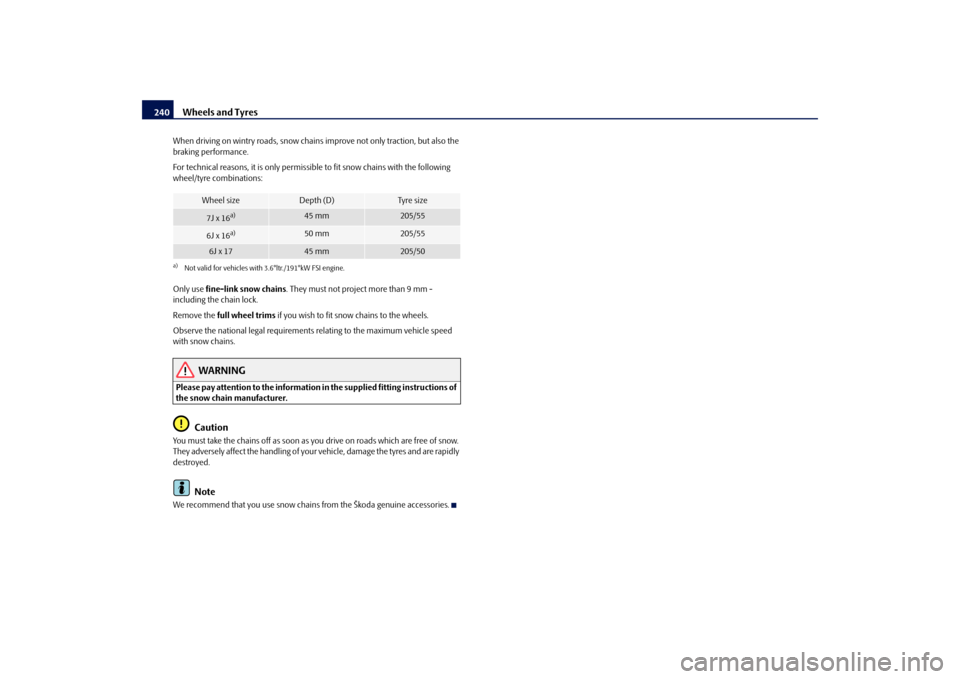
Wheels and Tyres
240
When driving on wintry roads, snow chains
improve not only traction, but also the
braking performance. For technical reasons, it is only permissi
ble to fit snow chains
with the following
wheel/tyre combinations: Only use
fine-link snow chains
. They must not project more than 9 mm -
including the chain lock. Remove the
full wheel trims
if you wish to fit snow
chains to the wheels.
Observe the national legal requirements
relating to the maximum vehicle speed
with snow chains.
WARNING
Please pay attention to the information in the supplied fitting instructions of the snow chain manufacturer.
Caution
You must take the chains off as soon as you drive on roads which are free of snow. They adversely affect the handling of your
vehicle, damage the tyres and are rapidly
destroyed.
Note
We recommend that you use snow chains
from the Škoda genuine accessories.
Wheel size
Depth (D)
Tyre si z e
7J x 16
a)
a)Not valid for vehicles with 3.6°ltr./191°kW FSI engine.
45 mm
205/55
6J x 16
a)
50 mm
205/55
6J x 17
45 mm
205/50
s2dk.1.book Page 240 Wednesday, April 8, 2009 12:23 PM